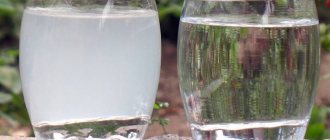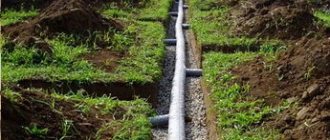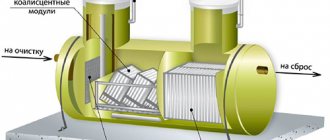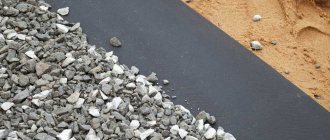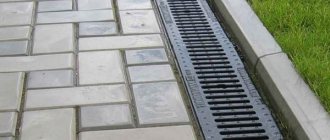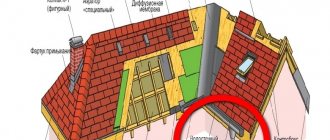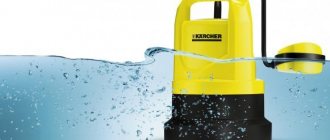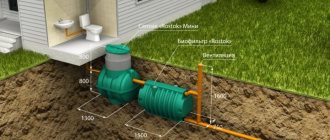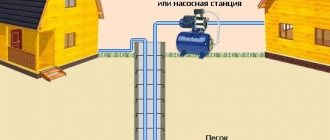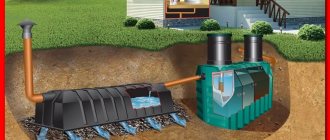With the help of drainage, underground water and rainwater are removed from the house and the site. Excess moisture can erode the foundation and flood the basement or garage. Excess water on the site destroys plants and makes the area swampy. On clay soil type, mandatory drainage is required because the soil does not absorb liquid well.
It is better to design drainage in the spring and autumn, when there is a lot of rainfall and groundwater rises. All calculations should be made based on observations at this time. As a rule, crushed stone is laid at the bottom of the drainage system, which has unturned corners, because the material was obtained during mechanical crushing. This is the advantage of using crushed stone over gravel.
Crushed stone particles do not compact over time due to their shape, retaining the ability to pass water. You need to be able to determine which crushed stone is best suited for drainage.
Foundation drainage from Jheka
JhekaFORUMHOUSE Member
While it’s still hot and everything that can be dried out, it’s time to do drainage. Our groundwater is quite close; in winter, when the water freezes, heaving sometimes occurs under the blind area. Now under the blind area there is insulation, 100 mm EPPS, but, nevertheless, it was decided to do drainage.
The watershed will begin from the entrance to the house, the pipes will go to the sides and along the entire perimeter. There is one concrete collector well planned, behind the fence opposite, with pumping of wastewater into a ditch.
The foundation is a monolithic shallow tape; a meter was removed from the Jheka blind area and a trench 40 cm wide was marked out to make digging easier.
Differences between crushed stone and gravel
These two concepts are confused with each other. This state of affairs is influenced by the name “crushed gravel”. Sellers who want to sell as much product as possible also help create confusion. The differences between them are the following:
Gravel
Crushed stone
Natural material. It is produced by artificial destruction of rocks.
Obtained by crushing.
It cakes quickly, which impairs the volume of drainage. The quality of the trench will be reduced by impurities that are always present in the material.
Good drainage is ensured by the angular features and structure of the material. Crushed stone contains almost no impurities.
In terms of adhesion, crushed stone is superior to gravel, which is why it is often used in construction work.
Excavation
The top point of the drain was planned opposite the door, at 50 cm, but in the process 50 cm turned into 60 cm. At the same time, an underground electrical cable entry was organized. The slope in the trench is 1 cm per linear meter. For sampling in the lawn area, plywood and PE film were laid.
We performed a puncture.
Grain size
Based on the size of individual stones, any crushed stone is divided into several fractions.
The so-called granite screenings or crumbs. This is residual dust resulting from crushing. Maximum dimensions – 5 mm. Fine fraction.
For most construction purposes, it is the most in demand, and therefore the most expensive in price. The grain size is from 5 to 20 mm. Medium crushed stone includes stones 20-40 mm. In the large fraction, the size of crushed stone reaches 7 cm. Non-standard includes elements larger than 70 mm; can reach 120. Non-standard crushed stone is usually used for decorative purposes.
When arranging drainage, the fine fraction is not suitable: the grains pass into the drainage holes, and the filtration capacity (due to the same small size) is very low. Backfilling of the middle fraction is considered optimal: prevention of siltation has the highest indicators, the crushed stone itself does not clog drains. Larger crushed stone will significantly allow dirt and silt to pass through, which leads to breakage of the pipes themselves and failure of the geotextile in which they are wrapped.
In some cases, granite screenings are used as the base layer of the pillow, replacing expanded clay or sand. The feasibility of such a substitution is questionable, since it is more expensive, and dust inclusions (comprising up to a quarter of the screening volume) can get into the pipes during flooding.
The deep drainage system, in which the ditch has a depth of more than 80 centimeters, has its own characteristics. In this case, crushed stone of large fractions, with a grain size of 4-7 cm, is recommended for use.
Components and materials
Drainage pipe in geotextiles, geotextiles for needle-punched trenches, heat-treated, width 1.5 m, density 150 g/m², drainage wells, covers, adapters. Crushed granite, fraction 5-20 and 5-40.
Filling with sand while maintaining the slope.
Jheka
The first thing I want to say to those who will do the drainage is to use only washed crushed stone and fractions of 20-40! No 5-20 like mine. Here is my crushed stone, which means unwashed.
A layer of crushed stone cushion on top of geotextile about 5 cm thick.
The next batch of crushed stone is also unwashed, but already of fraction 5-40, although it is too small.
By the way, crushed stone can be washed, especially if you have a high-pressure washer. And if crushed stone has been replaced with gravel out of necessity, and it is in clay, it is necessary to wash it. Otherwise, the clay will be washed away directly into the trench and silt up the geotextile.
resergelFORUMHOUSE Member
Definitely wash. I also have gravel in clay, washed with Karcher. I made a frame with a mesh, like for sifting sand, and washed it in portions, washing it for a long time - about two weeks every day.
What crushed stone is suitable for arranging drainage
We talked about what types of drainage systems there are. Crushed stone must be selected depending on what kind of drainage you need.
Here are some points to pay attention to:
- When equipping drainage for sewerage and septic tanks, take granite crushed stone 5-20, 20-40, 40-70 or limestone 20-40. They are of optimal size and quality, and are also cheaper than other varieties.
- If you need to equip a large filtration field or lay a large sewer, pay attention to granite crushed stone 20-70, marble 40-70, serpentinite 40-70.
- When arranging drainage for plants on alkaline soil, take granite crushed stone 5-25.
- If you want to make drainage for trees and bushes, while increasing the acidity of the soil, take crushed limestone 5-20.
- To fill a hole under a tree, you should not use too large stones. Optimal options with the best price-quality ratio: crushed limestone 5-20, marble variety with grain sizes 5-20, 10-20, 20-40.
- Crushed marble 5-10 is suitable for indoor and greenhouse plants.
Advice: do not buy too expensive material. For example, the drainage layer under plants can be made from alternative inexpensive materials. More on this in the last part of the article.
Installation of drainage system and backfilling
We continue - inserting the coupling into the well (first, with a thick drill, to the required diameter, with a jigsaw).
Drainage pipe laid on top of crushed stone preparation.
Rotary, also known as an inspection well.
On rotary wells, I swapped the bottom and lids - it is easier to collect silt deposits from a flat surface, if necessary.
To fill the drainage trench, Jheka used sifted crushed stone, to save money, he narrowed the trench a little on the sides with sand. The thickness of the crushed stone layer in the backfill varies between 5-7 cm, the crushed stone is covered with geotextiles, and sand is placed on top, in a layer of about 20 cm.
The remaining centimeters were filled partly with earth, partly with river and quarry sand.
Choosing a suitable drainage fraction - recommendations from experts
A lot depends on the fraction of the material, which you also need to know about in order to make drainage high-quality and practical, because this affects the entire system. Unfortunately, few people pay attention to this factor, missing it, which ultimately often leads to problems. Crushed stone can be divided into the following fractions, which depend on the size of the “grain”:
- Small crushed stone – up to 2 cm.
- Medium – up to 4 cm.
- Large – up to 7 cm
- Material of non-standard shape – up to 12 cm.
- Screening is the residual material of crushing, in which the material reaches only 5 mm.
You can also use well-washed screenings instead of expanded clay or fine sand when laying the bottom layer of drainage. Small crushed stone is the most expensive type, however, despite this, it is in great demand. However, it is not very suitable for creating drainage due to its small size and poor filtration capabilities.
For practical arrangement of the system, medium-sized crushed stone (up to 4 cm) is most often used. This option can be called the most optimal, since such material provides high-quality filtration, eliminating contaminants and stopping siltation. Large fractions are characterized by the passage of dirt and small debris, which threatens pipe breakdowns.
Installation of a collector well
Jheka did not immediately cut and deepen the rotary wells; he postponed it until the stage of landscaping the yard.
The collector well was assembled from two concrete rings with a diameter of 90 cm, a lid and a hatch. The rings were lowered into place using a manipulator.
Why do we need crushed stone?
It would seem that drainage pipes have been laid - and the formation of the drainage system is completed. However, it is not for nothing that this is precisely the system. The crushed stone in it performs two important functions.
Firstly, it serves as a filter.
Pipes for draining water are produced with holes that let it inside. And the incoming drain water must be cleared of large debris and silt so that the drains do not become clogged. This is what the crushed stone layer does. The cushion, built from crushed stone with sand, serves as the basis for the entire drainage system.
If it is closed, crushed stone is poured both from the sides and from above. If it is open, in addition to the bottom, it strengthens the walls of the ditch. Crushed stone protects pipes from damage by external pressure.
And the extent to which these tasks will be accomplished depends on how correctly it is selected.
Operating experience
Jheka
During operation this fall, the drainage worked well. There is a lot of water, we have to pump it out twice a day. The water in the well collects above the drainage pipe.
But here it is worth noting that the storm drainage system has not yet been completed - through trays laid under the drainpipes, roof water is simply discharged into the ground, at a distance of about five meters from the house. According to the participants in the topic, with which the topicstarter is inclined to agree, it is these surface runoff that infiltrate and enter the drainage system, which leads to large volumes.
However, the system overwintered normally, and in the spring the site was drier, although some problems emerged - in the corners the soil swelled along with the blind area. Typically, this is the third winter for the blind area.
To avoid a recurrence, I first cut off the wells and insulated the covers with EPS (a layer of earth on top of about 8 cm) - it got better, but next spring the blind area was raised again. Therefore, in the summer I dug a trench parallel to the blind area in the corner areas and inserted EPS slabs also vertically. Considering that to this day Jheka has not reported any problems, most likely the system has been working properly for almost ten years.
Types of crushed stone
Crushed stone used for the drainage system comes in different types. The following types are distinguished:
1.granite type.
2.gravel type.
3.secondary type.
4.slag type.
5. limestone (dolomite) type.
Granite is considered the most durable type of gravel.
It has a long service life, is frost-resistant, and is durable. Among the disadvantages, one can highlight its high price; it is considered radioactive. When purchasing a granite type, you should check the level of radioactivity using the certificate. The first class of radioactivity is suitable for use, equal to no more than 370 BC per kilogram. Attention! The granite type is considered the most durable with a service life of up to forty years.
The gravel type consists of crushed rock. The material is not as durable as granite, but is considered less radioactive and expensive. The two types have the same bulk density and particle shape.
The limestone type of crushed stone is obtained from sedimentary rock. This type is one of the cheapest types. It has absolutely no radioactivity, therefore it is safe for others. Not as durable as the first two types. Crushed stone will last up to fifteen years. Crushed stone can be used in special conditions: in dry, non-freezing soil with low acidity.
Recycled crushed stone is crushed construction waste. The material used is the remains after demolishing a house or replacing asphalt pavement. Crushed stone is very cheap, and it is neither durable nor frost-resistant. The slag type of crushed stone is formed by crushing slag residues in metallurgy.
Which drainage material is preferable?
Crushed stone must be of the best quality. The best option is granite material. Lime or gravel types are somewhat inferior.
You also need to pay attention to the size of crushed stone for drainage. A fraction of 20-40 mm is considered ideal. This size best copes with filtration functions; it is well suited for work by those who deal with drainage installations themselves.
If you take larger material, it will not cope with filtration.
Particles of dirt and silt will begin to slip into the resulting gaps in the crushed stone and penetrate the pipes. If the pipes are wrapped in geotextile, foreign impurities will render this material unusable. And crushed stone that is too small will itself act as a pollutant.
Why is crushed stone better than other materials?
Some sources say that other materials can be used instead of crushed stone. For example, gravel or expanded clay drainage, the main thing is that the fractions are suitable. But experts with extensive experience are still inclined to believe that if it is possible to use crushed stone, then it is better to purchase it.
Other materials (gravel, etc.) are most often smooth fragments that were once rocks. Crushed stone has sharp corners.
Such edges are much better at retaining foreign mechanical components, silt particles, etc. At the same time, the cost of crushed stone is practically no different from its “analogs,” although the efficiency of use is several times higher.
However, even if you managed to buy high-quality material of the required fraction, remember that the quality of its work in the drainage system is directly proportional to how correctly you installed it. Therefore, several conditions must be observed: Before use, the crushed stone is washed very thoroughly - this ensures that the pipes will not silt.
The exact calculation of the thickness of the layer that you will lay - you need to focus on the density of the soil.
Correct laying angle - water should flow to the pipes on its own.
By observing all these conditions, you can make an excellent drainage system with your own hands that will last for many years.
Drainage is used to drain soils in summer cottages and construction sites. And many people are concerned about the question of what crushed stone is used for drainage. After all, the right choice of material will allow you to make a high-quality and efficient structure!
Buy crushed stone for a septic tank in Moscow
Our company supplies crushed stone, sand and other materials. Having worked in the non-metallic materials industry since 2012, we are well versed in them. Therefore, we will always recommend the fraction and type of crushed stone that is best suited for the construction of a septic tank. Delivery is carried out around the clock within Moscow and the Moscow region. We conclude an official contract and guarantee high quality products.
Still have questions regarding the choice of materials? Contact the managers of our company for advice and receive qualified advice.
physical characteristics
The choice is not made until familiarization with the standard characteristics and analysis of the necessary indicators.
Physical characteristics of crushed stone: flakiness, frost resistance, strength, radioactivity.
Flakiness
Flakiness is a sign indicating elongation and compactness of components. With quality, flakiness is inversely related; an increase in the indicator indicates deterioration of the material.
Material with high flakiness is suitable for drainage under roads and railways.
Flakiness divides crushed stone into types:
- Ordinary;
- Cubiform;
- Flaky;
- Improved;
- Combined fraction.
The best one is cuboid. The cubic shape is compacted more densely than others.
Frost resistance
The parameter in the marking is indicated by the letter F and a number. The number is set based on the number of freezing and thawing cycles that the material can withstand.
Crushed stone has a range of numbers - 15-400. For construction, it is reasonable to choose 200-300.
Radioactivity
Testing for radioactivity is confirmed by a certificate of conformity provided in stores.
Crushed stone is divided into three categories, only two are used in construction in residential areas. For safety reasons, the first one is preferable.
Strength
Strength depends on the original rock. Dense - primary masses (gravel, granite, limestone, marble). The most durable is granite.
Strength is indicated on the packaging labeling and is specified in the documents.
Process

